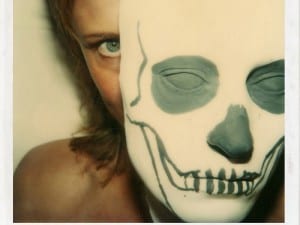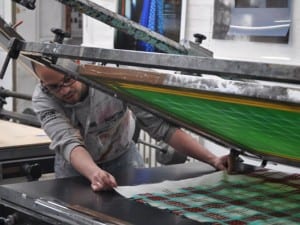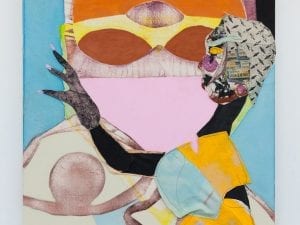Review by Charles Danby
From Grafton Street there was little to see. The large glazed exterior of London’s Sprüth Magers offered a near empty room and a side view of a 16mm projector towards its left end, an upfront disclosure of Croatian artist David Maljkovic’s alluring economy and deft intransience towards slightness and concealed thresholds.
On closer inspection the room was, in fact, divided across its width by three slices of line / object, the projector to the left, facing and projecting inwards, a suspended screen to the right of centre, and a heavily framed photograph of similar size hanging on the right side wall.
On entering the space, through a door into the room from the left side, the exterior view across the work, and across the span of its purported projection, from light source on the left to image on the right, was vicariously reversed. Walking in directly behind the 16mm projector the view presented by Maljkovic was as if from “over the shoulder” of the projectionist. A gaze to an eponymous (and actual) silver screen, that floating and seemingly weightless in its suspended form, obscured the photograph which was now directly behind it on the back wall. The stretched silver fabric of the screen – pulled across a simple wooden frame – was marked, scratched, creased, folded and hemmed, giving it a series of vertical and horizontal lines across its surface that were picked-up and animated by the cast projection.
The white light projected from the machine illuminated a matching rectangle within the linear edges of the screen, and in doing so constructed the frame and “image”, which at the same time, through a lack of light, established darkness across the remainder of the surface optically transforming it into a frame or boarder. The moving frames of white light flickered across the screen with juddering uniformity. Light was also cast back from the reflective silver surface, creating a “sunspot” that obscured and moved across the surface with each altered angle of gaze.
Walking through the space and around the silver screen the photographic print could be viewed. It was a “recalled frame” (the title of the show Recalling Frames) from Orson Welles’ The Trail (1962) after Franz Kafka’s 1925 novel of the same name. Kafka’s character and the story of Joseph K (the protagonist in The Trail) is one of action and inaction, of narrative suspended within narrative, inverted, circular and ultimately ungraspable – in so much as that absurdity plays through as both cause and effect. It was here that the industry of Maljkovic, in unpicking and constructing layers of image, material and idea, whilst with it making leaps (metaphorical and actual) between them – of silver screen – made emptiness dissolve.
The photographic print showed a man (the actor Anthony Perkins playing Joseph K) standing in a darkened warehouse with a large empty rectangular light screen behind him. It is a position from which in Welles’ film he speaks directly to camera. Here Maljkovic has removed a rectangular section from the “screen”’, an incision that includes the removal of a large portion of the man, from his waist and elbows upwards. The residual cut marks of Maljkovic’s interaction with his source image were clearly visible within the photograph, which was also marked at its peripheries to the top, sides and bottom, by the text and numeric markings of the film stock used.
In correlating the cut black rectangle of the photograph to the actual suspended silver screen within the space, and the light screen behind the man’s head in the photograph to the projector at the other end of the room, the photograph took on a strange instructional dynamic. It seemingly directed the viewer where to stand within the “installed” elements of screen and projected light, to allow for the photograph to be both replicated, in real time, and at the same moment to have its image inverted within real space.
Permeating throughout the space was an audio track, excerpts taken from Welles’ film, slipping dialogue that seemed to poignantly echo from the darkened corners and recesses around the photographed figure.
Away from the glass frontage a second room showed four even sized photographic works, matching in size and framing to the one in the first room. These showed layered montages of film stills (again from Welles’ The Trial) cut with photographs taken by Maljkovic of the same buildings that featured in the stills, shot from the same angles. Much of Welles’ The Trail was filmed in the streets of Zagreb, and Maljkovic engendered this, constructing through image intersections of real space that cut through layers of recent past within Croatia and its former status as SFR Yugoslavia.
In one of the affecting works [all titled Recalling Frames (2010)] three silhouetted figures huddled to the left of centre of the frame, as if in dialogue, seeming to occupy an internal space, they evoked some sentiment of an inverted Edward Hopper painting, being instead collectively refracted through a complex matrix of intersecting external spaces. Maljkovic’ s works retained a sense of compositional mapping, of cinematic movement and rich opportunity for the detail often missed, or simply unseen, in the unrelenting spin and cycle of flickering light and silver screen.
Recalling Frames closed on 23 December 2010. The next show to open at Sprüth Magers, London will be Cindy Sherman on 12 January. www.spruethmagers.com
Image © David Maljkovic courtesy Sprüth Magers





